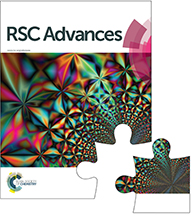Phyto-inspired Cu/Bi oxide-based nanocomposites: synthesis, characterization, and energy relevant investigation
Abstract
A modified and sustainable approach is reported in this research for the synthesis of a spherical-shaped CuO–Bi2O3 electrode material for electrochemical studies. Aqueous extract derived from the plant Amaranthus viridis L. (Amaranthaceae) (AVL) was used as a reducing agent for morphological control of the synthesis of CuO–Bi2O3 nanocomposites. The modified nanomaterial revealed an average crystal size of 49 ± 2 nm, which matches very well with scanning electron microscopy (SEM) findings. Furthermore, the synthesized material was characterized using Fourier-transform infrared spectroscopy, field emission SEM and energy-dispersive spectroscopy. The optical band gap energy of 3.45 eV was calculated using a Tauc plot. Finally, the bioorganic framework-derived CuO–Bi2O3 electrode was tested for energy generating and storage applications and the results revealed a capacitance of 389 F g−1 by cyclic voltammetry, with a maximum energy density of 12 W h kg−1 and power density of 5 kW kg−1. Hydrogen evolution reaction and oxygen evolution reaction studies showed good potential of CuO–Bi2O3 as an electrocatalyst for water splitting, with maximum efficiency of the electrode up to 16.5 hours.



 Please wait while we load your content...
Please wait while we load your content...